Night Thermal Unmixing for the Study of Microscale Surface Urban Heat Islands with TRISHNA-Like Data
Abstract
:1. Introduction
2. Datasets
2.1. DESIREX Dataset
2.2. Multispectral Satellite Modelling
3. Methodology
3.1. Thermal Unmixing Techniques
- First, LST behaves as a function of a given reflective index at the coarse resolution L. Depending on the technique, this relationship is linear for DisTrad and ATPRK, Equation (3), locally linear for AATPRK, Equation (4), or fourth order polynomial for HUTS, Equation (5). A regression at this resolution allows to obtain the parameters characterizing the behavior of LST versus index.where both LST and indices depend on the pixel location x ( and for coarse and fine resolutions respectively). a and b are the intercept and slope obtained in the regression with DisTrad and ATPRK. and are the local intercept and slope obtained for coarse pixel by performing the regression with the N coarse pixels around [20]. Parameters are those obtained in the polynomial regression.
- Second, the behavior of the LST in function of the index and the regression parameters defining this behavior are scale invariant. Therefore, they can be used together with the measured index at the fine scale to estimate the LST at this resolution, Equation (6) for DisTrad and ATPRK, Equation (7) for AATPRK, and Equation (8) for HUTS.
- Third, the residuals estimation of the fine resolution LST are also based on an scale invariance. DisTrad residuals correction supposes that the coarse resolution residuals are equal to the fine resolution ones, Equation (9). ATPRK and AATPRK present a more complex estimation of the fine scale residuals based on a weighted linear combination of surrounding coarse scale residuals, Equation (10). The weights of this method are those optimizing the estimator: the bias has to be zero and the variance has to be minimal [20,25]. Finally, HUTS links the pixel LST reconstruction error to the fine residual, Equation (11).where of Equation (10) are the weights of the surrounding coarse pixels used in the estimation of the fine residual. In Equation (11), is the number of fine pixels within a coarse one.
3.2. Night Unmixing
3.3. SUHI and Microscale SUHI Estimation
3.4. Evaluation Criteria
4. Results and Discussion
4.1. Night-LST vs. Day-Index Regressions
4.1.1. Global Linear Behavior: DisTrad and ATPRK
4.1.2. Local Linear Behavior: AATPRK
4.1.3. Polynomial Behavior: HUTS
4.2. SUHI Estimation from Unmixed Night-LST
5. Conclusions
Author Contributions
Funding
Conflicts of Interest
Appendix A. Results for 01-07-2008 and 04-07-2008
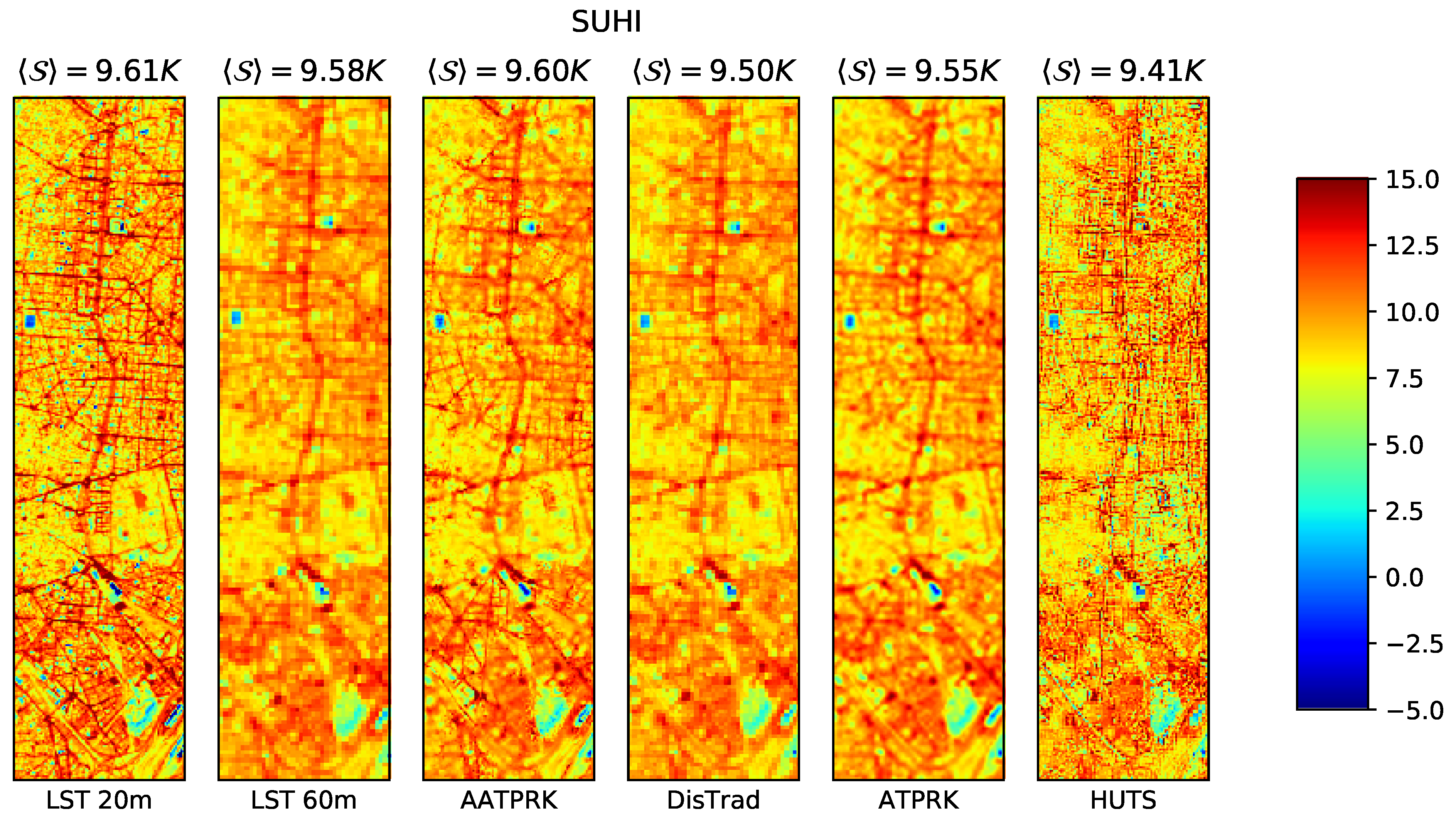

| 01/07/2008 | |||||
|---|---|---|---|---|---|
| City Center | |||||
| Unmixing Resolutions | Method | RMSE (K) | MBE (K) | R | SSIM |
| 60 m → 20 m | DisTrad | 1.73 | 0.03 | 0.70 | 0.30 |
| ATPRK | 1.60 | 0.04 | 0.76 | 0.38 | |
| AATPRK | 1.51 | −0.00 | 0.78 | 0.49 | |
| HUTS | 2.82 | 0.03 | 0.31 | 0.00 | |
| 60 m | 1.70 | 0.03 | 0.72 | 0.33 | |
| Whole Image | |||||
| Unmixing Resolutions | Method | RMSE (K) | MBE (K) | R | SSIM |
| 60 m → 20 m | DisTrad | 1.72 | 0.02 | 0.91 | 0.39 |
| ATPRK | 1.56 | 0.02 | 0.93 | 0.48 | |
| AATPRK | 1.56 | 0.00 | 0.93 | 0.52 | |
| HUTS | 2.36 | 0.02 | 0.83 | 0.26 | |
| 60 m | 1.71 | 0.02 | 0.91 | 0.40 | |
| 04/07/2008 | |||||
|---|---|---|---|---|---|
| City Center | |||||
| Unmixing Resolutions | Method | RMSE (K) | MBE (K) | R | SSIM |
| 60 m → 20 m | DisTrad | 1.64 | 0.02 | 0.72 | 0.34 |
| ATPRK | 1.51 | 0.03 | 0.78 | 0.42 | |
| AATPRK | 1.46 | −0.02 | 0.78 | 0.50 | |
| HUTS | 2.78 | 0.03 | 0.32 | 0.03 | |
| 60 m | 1.63 | 0.02 | 0.73 | 0.35 | |
| Whole Image | |||||
| Unmixing Resolutions | Method | RMSE (K) | MBE (K) | R | SSIM |
| 60 m → 20 m | DisTrad | 1.57 | 0.02 | 0.87 | 0.39 |
| ATPRK | 1.42 | 0.02 | 0.90 | 0.48 | |
| AATPRK | 1.41 | −0.00 | 0.90 | 0.52 | |
| HUTS | 2.33 | 0.01 | 0.72 | 0.21 | |
| 60 m | 1.56 | 0.02 | 0.87 | 0.40 | |
References
- Rizwan, A.; Dennis, L.; Chunho, L. A review on the generation, determination and mitigation of urban heat island. J. Environ. Sci. 2008, 20, 120–128. [Google Scholar] [CrossRef]
- Hart, M.; Sailor, D. Quantifying the influence of land-use and surface characteristics on spatial variability in the urban heat island. Theor. Appl. Climatol. 2009, 95, 397–406. [Google Scholar] [CrossRef]
- Huang, H.; Ooka, R.; Kato, S. Urban thermal environment measurements and numerical simulation for an actual complex urban area covering a large district heaheat and cooling system in summer. Atmos. Environ. 2005, 39, 6362–6375. [Google Scholar] [CrossRef]
- Sarrat, C.; Lemonsu, A.; Masson, V.; Guedalia, D. Impact of urban heat island on regional atmospheric pollution. Atmos. Environ. 2006, 40, 1743–1758. [Google Scholar] [CrossRef]
- Kolokotroni, M.; Zhang, Y.; Watkins, R. The London heat island and building cooling design. Sol. Energy 2007, 81, 102–110. [Google Scholar] [CrossRef]
- Priyadarsini, R. Urban heat island and its impact on building energy consumption. Adv. Build. Energy Res. 2009, 3, 261–270. [Google Scholar] [CrossRef]
- Stone, B.; Norman, J. Land use planning and surface heat island formation: A parcel-based radiation flux approach. Atmos. Environ. 2006, 40, 3561–3573. [Google Scholar] [CrossRef]
- Kim, J.; Guldmann, J. Land-use planning and the urban heat island. Environ. Plan. B Urban Anal. City Sci. 2014, 41, 1077–1099. [Google Scholar] [CrossRef]
- Anniballe, R.; Bonafoni, S.; Pichierri, M. Spatial and temporal trends of the surface and air heat island over Milan using MODIS data. Remote Sens. Environ. 2014, 150, 163–171. [Google Scholar] [CrossRef]
- Jin, M.; Dickinson, R. Land surface skin temperature climatology: Benefitting from the strengths of satellite observations. Environ. Res. Lett. 2010, 5, 044004. [Google Scholar] [CrossRef]
- Tiangco, M.; Lagmay, A.; Argete, J. ASTER-based study of the night-time urban heat island effect in Metro Manila. Int. J. Remote Sens. 2008, 29, 2799–2818. [Google Scholar] [CrossRef]
- Sobrino, J.; Oltra-Carrió, R.; Sòria-Barres, G.; Jiménez-Muñoz, J.C.; Franch, B.; Hidalgo, V.; Mattar, C.; Julien, Y.; Cuenca, J.; Romaguera, M.; et al. Evaluation of the surface urban heat island effect in the city of Madrid by thermal remote sensing. Int. J. Remote Sens. 2013, 34, 3177. [Google Scholar] [CrossRef]
- Lagouarde, J.; Bhattacharya, B.; Crebassol, P.; Gamet, P.; Babu, S.; Boulet, G.; Briottet, X.; Buddhiraju, K.M.; Cherchali, S.; Dadou, I.; et al. The Indian–French Trishna mission: Earth observation in the thermal infrared with high spatio-temporal resolution. In Proceedings of the IEEE International Geoscience and Remote Sensing Symposium IGARSS, Valencia, Spain, 22–27 July 2018. [Google Scholar]
- Koetz, B.; Bastiaanssen, W.; Berger, M.; Defourny, P.; Bello, U.D.; Drusch, M.; Drinkwater, M.; Duca, R.; Fernandez, V.; Ghent, D.; et al. High spatio-temporal resolution land surface temperature mission—A Copernicus candidate mission in support of agricultural monitoring. In Proceedings of the IEEE International Geoscience and Remote Sensing Symposium IGARSS, Valencia, Spain, 22–27 July 2018. [Google Scholar]
- Lee, C.; Cable, M.; Hook, S.; Green, R.; Ustin, S.; Mandl, D.; Middleton, E. An introduction to the NASA Hyperspectral Infrared Imager (HyspIRI) mission and preparatory activities. Remote Sens. Environ. 2015, 167, 6–19. [Google Scholar] [CrossRef]
- Welch, R. Spatial resolution requirements for urban studies. Int. J. Remote Sens. 1982, 3, 139–146. [Google Scholar] [CrossRef]
- Zhan, W.; Chen, Y.; Zhou, J.; Wang, J.; Liu, W.; Voogt, J.; Zhu, X.; Quan, J.; Li, J. Disaggregation of remotely sensed land surface temperature: Literature survey, taxonomy, issues and caveats. Remote Sens. Environ. 2013, 131, 119–139. [Google Scholar] [CrossRef]
- Agam, N.; Kustas, W.P.; Anderson, M.; Li, F.; Neale, C. A vegetation index based technique for spatial sharpening of thermal imagery. Remote Sens. Environ. 2007, 107, 545–558. [Google Scholar] [CrossRef]
- Dominguez, A.; Kleissl, J.; Luvall, J.C.; Rickman, D.L. High-Resolution Urban Thermal Sharpener (HUTS). Remote Sens. Environ. 2011, 115, 1772–1780. [Google Scholar] [CrossRef]
- Wang, Q.; Shi, W.; Atkinson, P.M. Area-to-point regression kriging for pan-sharpening. ISPRS J. Photogramm. Remote Sens. 2016, 114, 151–165. [Google Scholar] [CrossRef]
- Granero-Belinchon, C.; Michel, A.; Lagouarde, J.P.; Sobrino, J.; Briottet, X. Multi-resolution study of thermal unmixing techniques over Madrid urban area: Case study of TRISHNA mission. Remote Sens. 2019, 11, 1251. [Google Scholar] [CrossRef]
- Wicki, A.; Parlow, E. Multiple regression analysis for unmixing of surface temperature data in an urban environment. Remote Sens. 2017, 9, 684. [Google Scholar] [CrossRef]
- Pereira, O.; Melfi, A.; Montes, C.; Lucas, Y. Downscaling of ASTER thermal images based on geographically weighted regression kriging. Remote Sens. 2018, 10, 633. [Google Scholar] [CrossRef]
- Essa, W.; Verbeiren, B.; van der Kwast, J.; van de Voorde, T.; Batelaan, O. Evaluation of the DisTrad thermal sharpening methodology for urban areas. Int. J. Appl. Earth Obs. Geoinf. 2012, 19, 163–172. [Google Scholar] [CrossRef]
- Wang, Q.; Shi, W.; Atkinson, P.M.; Zhao, Y. Dowsncaling MODIS images with area-to-point regression kriging. Remote Sens. Environ. 2015, 166, 191–204. [Google Scholar] [CrossRef]
- Sobrino, J.; Bianchi, R.; Paganini, M.; Sòria, G.; Jiménez-Muñoz, J.; Oltra-Carrió, R.; Mattar, C.; Romaguera, M.; Franch, B.; Hidalgo, V.; et al. DESIREX 2008: Dual-use European Security IR Experiment 2008; Technical Report; European Space Agency: Paris, France, 2009. [Google Scholar]
- Sobrino, J.; Bianchi, R.; Paganini, M.; Sòria, G.; Oltra-Carrió, R.; Romaguera, M.; Jiménez-Muñoz, J.; Cuenca, J.; Hidalgo, V.; Franch, B.; et al. Urban Heat Island and Urban Thermography project DESIREX 2008. In Proceedings of the 33rd International Symposium on Remote Sensing of Environment, ISRSE, Stresa, Italy, 4–8 May 2009. [Google Scholar]
- Oltra-Carrió, R. Thermal Remote Sensing of Urban Areas. The Case Study of the Urban Heat Island of Madrid. Ph.D. Thesis, Universitat de Valencia, Valencia, Spain, 2013. [Google Scholar]
- Miesch, C.; Poutier, L.; Achard, V.; Briottet, X.; Lenot, X.; Boucher, Y. Direct and Inverse Radiative Transfer solutions for visible and near-infrared hyperspectral imagery. IEEE Trans. Geosci. Remote Sens. 2005, 43, 1552–1562. [Google Scholar] [CrossRef]
- Zhang, X.; Zhong, T.; Wang, K.; Cheng, Z. Scaling of impervious surface area and vegetation as indicators to urban land surface temperature using satellite data. Int. J. Remote Sens. 2009, 30, 841–859. [Google Scholar] [CrossRef]
- Gillespie, A.; Rokugawa, S.; Matsunaga, T.; Cothern, J.S.; Hook, S.; Kahle, A.B. A temperature and emissivity separation algortihm for advanced spaceborn thermal emission and reflection radiometer (ASTER) images. IEEE Trans. Geosci. Remote Sens. 1998, 36, 1113–1126. [Google Scholar] [CrossRef]
- Kustas, W.P.; Norman, K.M.; Anderson, M.C.; French, A.N. Estimating subpixel surface temperatures and energy fluxes from the vegetation index—Radiometric temperature relationship. Remote Sens. Environ. 2003, 85, 429–440. [Google Scholar] [CrossRef]
- Essa, W.; Verbeiren, B.; van der Kwast, J.; Batelaan, O. Improved DisTrad for downscaling thermal MODIS imagery over urban areas. Remote Sens. 2017, 9, 1243. [Google Scholar] [CrossRef]
- Ben-Dor, E.; Saaroni, H. Airborne video thermal radiometry as a tool for monitoring microscale structures of the urban heat island. Int. J. Remote Sens. 1997, 18, 3039–3053. [Google Scholar] [CrossRef]
- Wang, Z.; Bovik, A.C. Mean Squared Error: Love it or leave it? IEEE Signal Process. Mag. 2009, 26, 98–117. [Google Scholar] [CrossRef]
- Liu, H.; Huete, A. A feedback based modification of the NDVI to minimize canopy background and atmospheric noise. IEEE Trans. Geosci. Remote Sens. 1995, 33, 457–465. [Google Scholar]

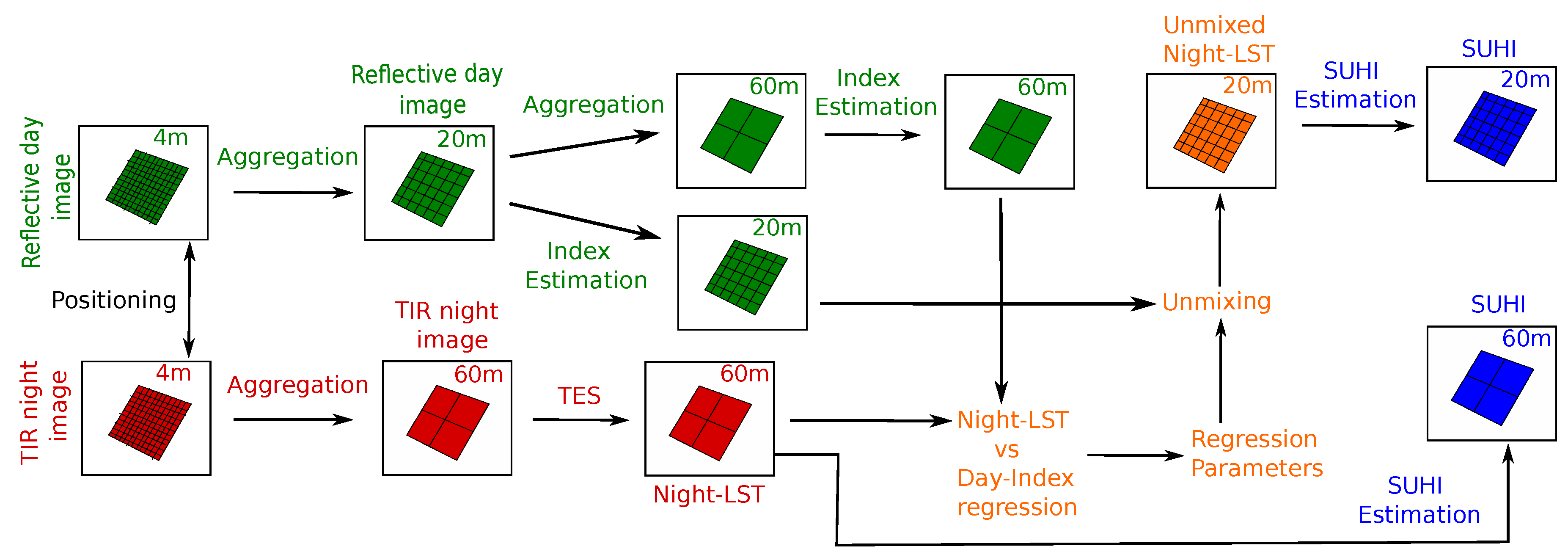
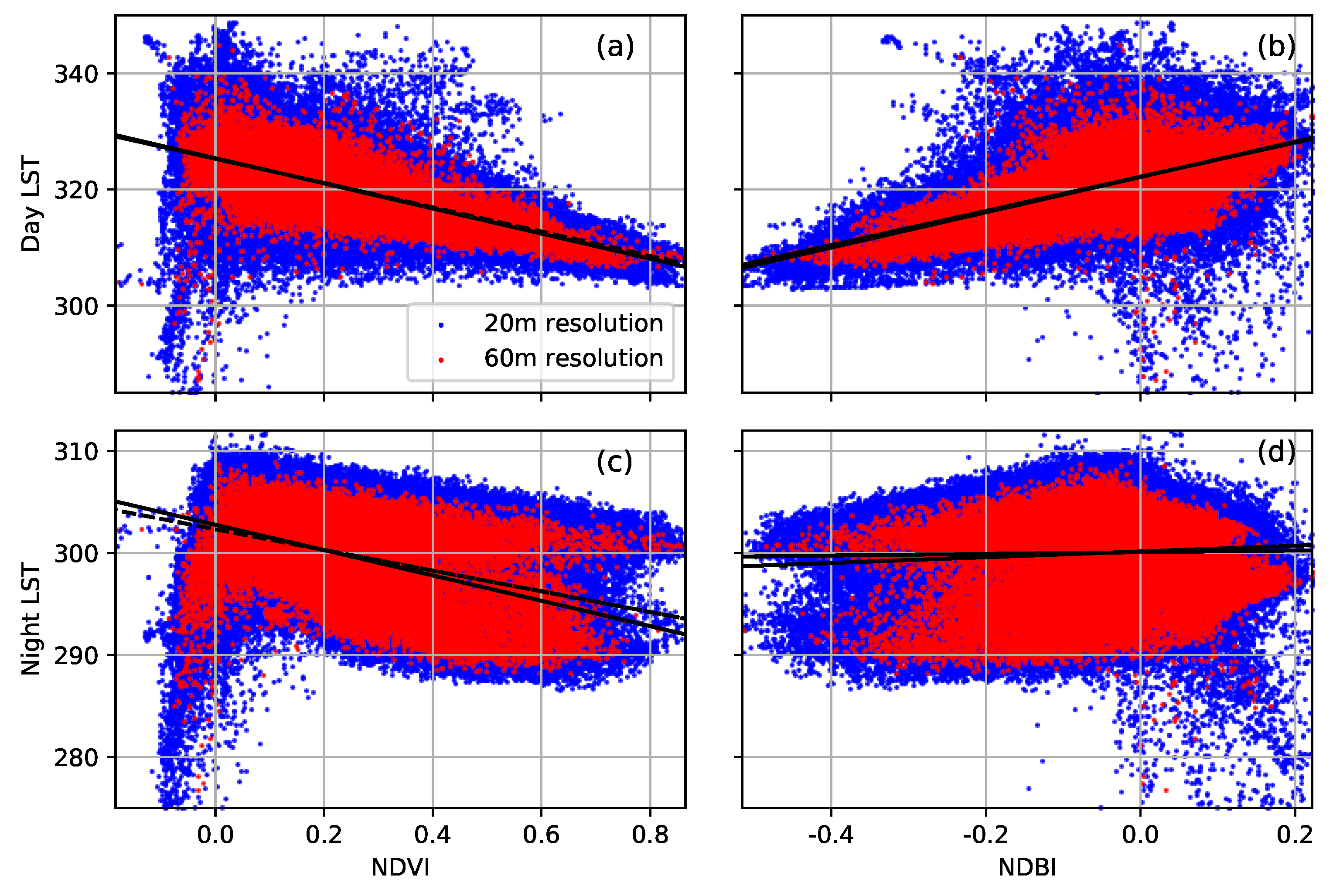
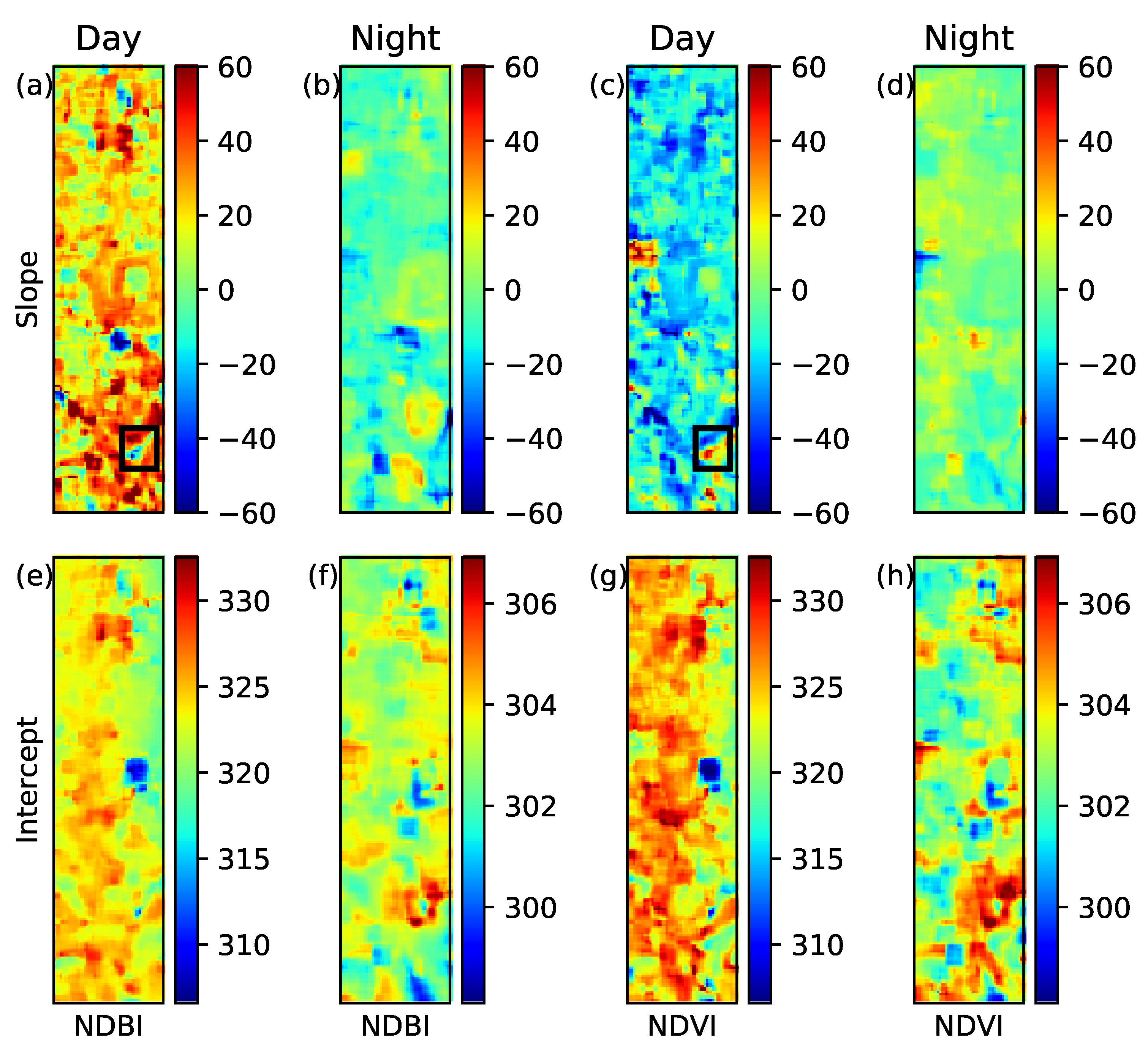
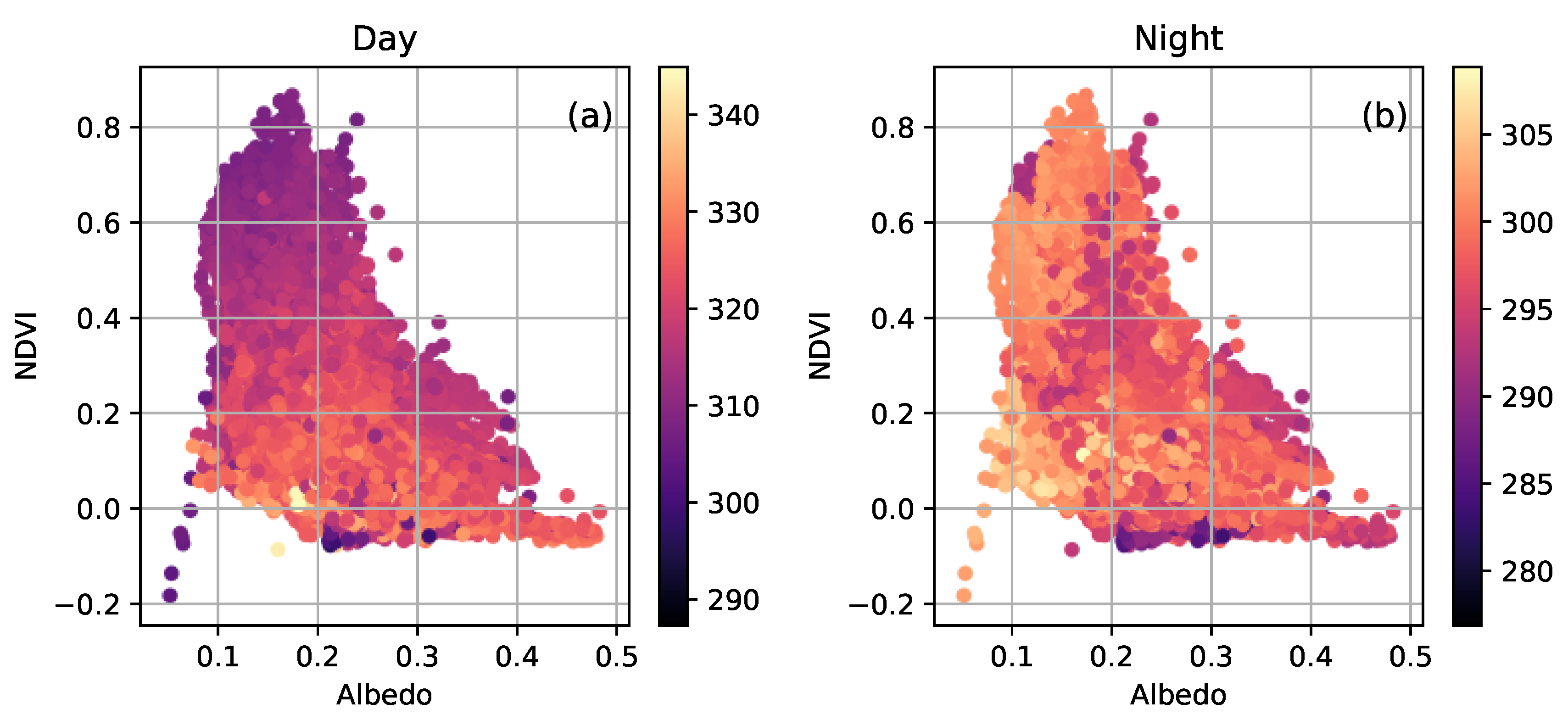
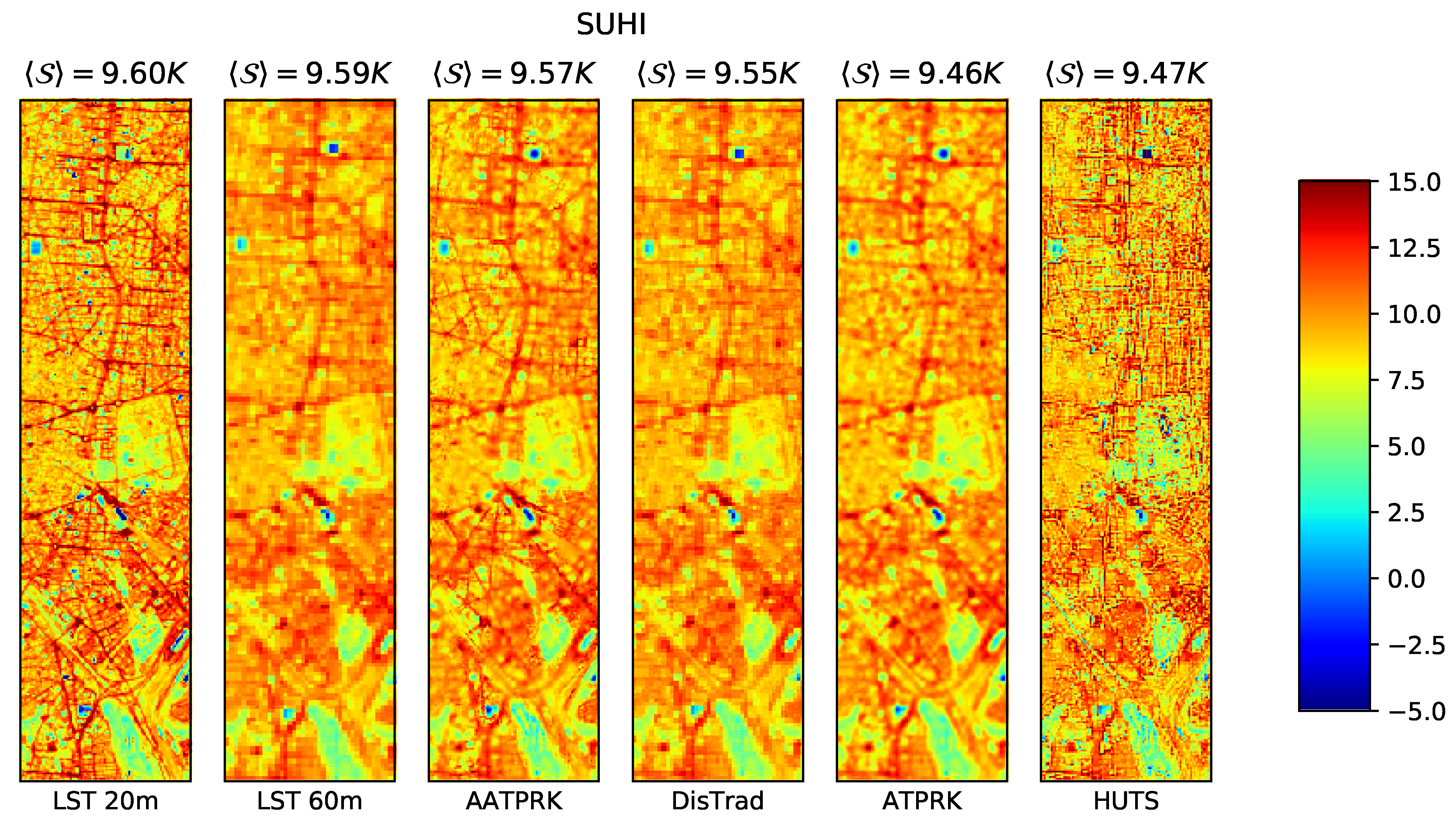

| TRISHNA Band | Wavelength Center | FWHM | Resolution |
|---|---|---|---|
| Band 1-Blue | 485 nm | 70 nm | 20 m |
| Band 2-Green | 555 nm | 70 nm | |
| Band 3-Red | 670 nm | 60 nm | |
| Band 4-NIR | 860 nm | 40 nm | |
| Band 5-SWIR | 1610 nm | 150 nm | |
| Band 6-TIR 1 | 8660 nm | 390 nm | 60 m |
| Band 7-TIR 2 | 9150 nm | 410 nm | |
| Band 8-TIR 3 | 10,590 nm | 550 nm | |
| Band 9-TIR 4 | 11,780 nm | 560 nm |
| 28/06/2008 | |||||
|---|---|---|---|---|---|
| City Center | |||||
| Unmixing Resolutions | Method | RMSE (K) | MBE (K) | R | SSIM |
| 60 m → 20 m | DisTrad | 1.63 | 0.02 | 0.73 | 0.32 |
| ATPRK | 1.49 | 0.04 | 0.78 | 0.40 | |
| AATPRK | 1.43 | −0.00 | 0.80 | 0.48 | |
| HUTS | 2.73 | 0.03 | 0.40 | 0.09 | |
| 60 m | 1.58 | 0.02 | 0.75 | 0.36 | |
| Whole Image | |||||
| Unmixing Resolutions | Method | RMSE (K) | MBE (K) | R | SSIM |
| 60 m → 20 m | DisTrad | 1.67 | 0.02 | 0.92 | 0.41 |
| ATPRK | 1.53 | 0.02 | 0.93 | 0.50 | |
| AATPRK | 1.49 | −0.00 | 0.94 | 0.53 | |
| HUTS | 2.58 | −0.05 | 0.78 | 0.33 | |
| 60 m | 2.65 | −0.02 | 0.88 | 0.42 | |
© 2019 by the authors. Licensee MDPI, Basel, Switzerland. This article is an open access article distributed under the terms and conditions of the Creative Commons Attribution (CC BY) license (http://creativecommons.org/licenses/by/4.0/).
Share and Cite
Granero-Belinchon, C.; Michel, A.; Lagouarde, J.-P.; Sobrino, J.A.; Briottet, X. Night Thermal Unmixing for the Study of Microscale Surface Urban Heat Islands with TRISHNA-Like Data. Remote Sens. 2019, 11, 1449. https://doi.org/10.3390/rs11121449
Granero-Belinchon C, Michel A, Lagouarde J-P, Sobrino JA, Briottet X. Night Thermal Unmixing for the Study of Microscale Surface Urban Heat Islands with TRISHNA-Like Data. Remote Sensing. 2019; 11(12):1449. https://doi.org/10.3390/rs11121449
Chicago/Turabian StyleGranero-Belinchon, Carlos, Aurelie Michel, Jean-Pierre Lagouarde, Jose A. Sobrino, and Xavier Briottet. 2019. "Night Thermal Unmixing for the Study of Microscale Surface Urban Heat Islands with TRISHNA-Like Data" Remote Sensing 11, no. 12: 1449. https://doi.org/10.3390/rs11121449







